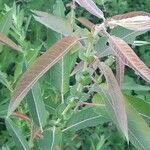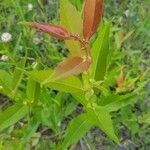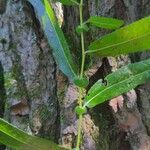Shrubs, 0.2-6 m, (sometimes forming clones by stem fragmentation). Stems: branches (sometimes highly brittle at base), red-brown, not glaucous, glabrous or glabrescent; branchlets yellow-brown to red-brown, pilose, moderately to densely velvety, pubescent, or villous, (inner membranaceous bud-scale layer free). Leaves: stipules foliaceous, (4.5-13 mm), apex rounded or acute; petiole shallowly grooved adaxially, 3-18 mm, tomentose adaxially; largest medial blade narrowly oblong, very narrowly elliptic or obovate, 58-96-136 × 9-21-36 mm, 2.3-4.6-8 times as long as wide, base cordate, convex, rounded, subcordate, or, sometimes, cuneate, margins flat, serrate or serrulate, apex acute to acuminate, abaxial surface thickly glaucous, glabrous, puberulent, sparsely pubescent or short-silky, adaxial highly glossy, glabrous or sparsely villous (hairs white, sometimes also ferruginous); proximal blade margins entire or shallowly serrulate; juvenile blade reddish or yellowish green, glabrous, pilose, or villous abaxially, hairs white. Catkins: staminate flowering just before leaves emerge, pistillate as leaves emerge; staminate slender or stout, 19-44 × 7-14 mm, flowering branchlet 0.5-5 mm; pistillate densely or moderately densely flowered, slender or stout, 22-65 × 7-14 mm, flowering branchlet 2-10 mm; floral bract dark brown or bicolor, 0.8-1.6 mm, apex rounded, abaxially hairy, hairs wavy. Staminate flowers: adaxial nectary narrowly oblong, oblong, or ovate, 0.2-1 mm; filaments distinct or connate less than 1/2 their lengths, glabrous; anthers yellow or purple turning yellow (ellipsoid or shortly cylindrical), 0.4-0.6 mm. Pistillate flowers: adaxial nectary oblong or flask-shaped, 0.3-0.8 mm, shorter than stipe; stipe 1.2-2.8 mm; ovary pyriform, glabrous, beak slightly bulged below styles; ovules 12-16 per ovary; styles 0.3-0.6 mm; stigmas flat, abaxially non-papillate with rounded tip, or broadly cylindrical, or 2 plump lobes, 0.16-0.28 mm. Capsules 3.5-7 mm. 2n = 38.
More
Shrub 2–4(–6) m, or sometimes arborescent; twigs, bud-scales, and petioles typically reddish-brown to dark brown, hairy when young; stipules semi-ovate to subreniform, 5–10(–15) mm, acutish, persistent; petioles 5–14 mm; lvs pubescent and reddish or purplish when young, later glabrous, typically oblong-lanceolate, serrulate, 7–12(–15) × 1.5–3(–4) cm, short-acuminate, rounded to subcordate at base, dark green above, ± glaucous beneath, rigid and veiny in age, catkins with or a little before the lvs, 2–5 cm, subsessile or on bracteate peduncles 3–10 mm; scales 1–1.5 mm, dark brown, crinkly-hairy; stamens 2; frs lance-ovate, 4–6 mm, glabrous; pedicels 1–2 mm; style ca 0.5 mm; 2n=38. Along watercourses and in lowlands; transcontinental, from Nf. and Que. to Va., w. to Yukon, B.C., and Calif.; disjunct in Ala., w. Ga., and w. Fla. (S. cordata Muhl., not Michx.; S. gracilis; S. lutea; S. missouriensis; S. rigida) Complex sp., probably consisting of several vars., but the limits of these not yet clearly understood.




